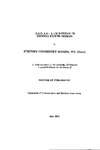NATURAL ALGORITHMS IN DIGITAL FILTER DESIGN
| dc.contributor.author | PENBERTHY HARRIS, STEPHEN | |
| dc.contributor.other | Faculty of Science and Engineering | en_US |
| dc.date.accessioned | 2013-11-19T11:45:59Z | |
| dc.date.available | 2013-11-19T11:45:59Z | |
| dc.date.issued | 2001 | |
| dc.identifier | NOT AVAILABLE | en_US |
| dc.identifier.uri | http://hdl.handle.net/10026.1/2752 | |
| dc.description.abstract |
Digital filters are an important part of Digital Signal Processing (DSP), which plays vital roles within the modern world, but their design is a complex task requiring a great deal of specialised knowledge. An analysis of this design process is presented, which identifies opportunities for the application of optimisation. The Genetic Algorithm (GA) and Simulated Annealing are problem-independent and increasingly popular optimisation techniques. They do not require detailed prior knowledge of the nature of a problem, and are unaffected by a discontinuous search space, unlike traditional methods such as calculus and hill-climbing. Potential applications of these techniques to the filter design process are discussed, and presented with practical results. Investigations into the design of Frequency Sampling (FS) Finite Impulse Response (FIR) filters using a hybrid GA/hill-climber proved especially successful, improving on published results. An analysis of the search space for FS filters provided useful information on the performance of the optimisation technique. The ability of the GA to trade off a filter's performance with respect to several design criteria simultaneously, without intervention by the designer, is also investigated. Methods of simplifying the design process by using this technique are presented, together with an analysis of the difficulty of the non-linear FIR filter design problem from a GA perspective. This gave an insight into the fundamental nature of the optimisation problem, and also suggested future improvements. The results gained from these investigations allowed the framework for a potential 'intelligent' filter design system to be proposed, in which embedded expert knowledge, Artificial Intelligence techniques and traditional design methods work together. This could deliver a single tool capable of designing a wide range of filters with minimal human intervention, and of proposing solutions to incomplete problems. It could also provide the basis for the development of tools for other areas of DSP system design. | en_US |
| dc.language.iso | en | en_US |
| dc.publisher | University of Plymouth | en_US |
| dc.title | NATURAL ALGORITHMS IN DIGITAL FILTER DESIGN | en_US |
| dc.type | Thesis | |
| plymouth.version | Full version | en_US |
| dc.identifier.doi | http://dx.doi.org/10.24382/4387 |
Files in this item
This item appears in the following Collection(s)
-
01 Research Theses Main Collection
Research Theses Main


